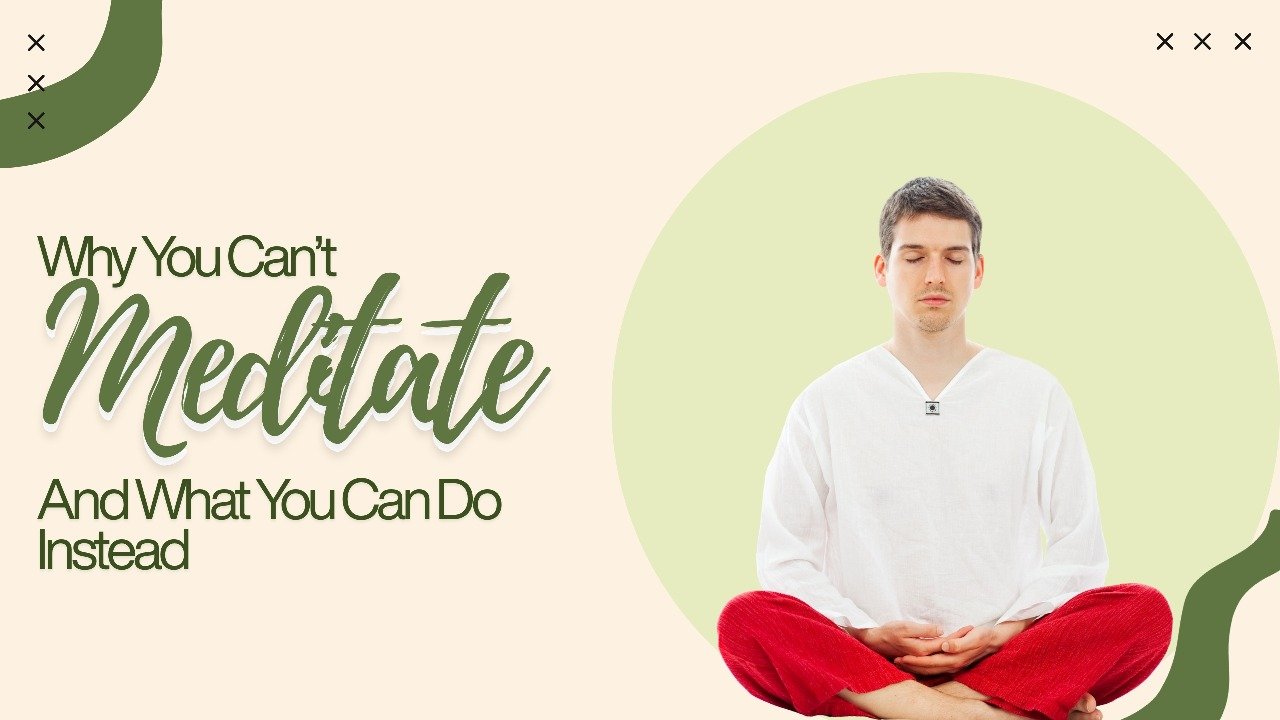Let’s be honest. You’ve tried to meditate. You downloaded the app, lit the candle, sat cross-legged like the calm people in Instagram reels… and 47 seconds later, you were mentally planning dinner, reliving that awkward conversation from 2016, and scratching an itch you didn’t have before you sat down.
Sound familiar? Your brain is just being… a brain.
Meditation is one of the most powerful tools for mental, emotional, and even cardiovascular health, but for many people, the traditional “sit still and empty your mind” approach feels impossible. The good news? Science has answers.
The Science of “Why Can’t I Meditate?”
First, let’s debunk the biggest myth: meditation is not about shutting your brain off. That’s impossible, your brain is designed to think.
Research in neuroscience shows that when you’re at rest, your default mode network (DMN), the brain system responsible for daydreaming, self-reflection, and mental chatter, lights up like a Christmas tree. For beginners, sitting quietly can make DMN activity spike, leading to more mental noise, not less.
Add in modern lifestyle stressors; chronic stress, poor sleep, overuse of screens, caffeine overload, and your nervous system is often in a low-grade fight-or-flight mode. Asking your body to “just relax” in this state is like asking a running blender to suddenly be silent.
Common (But Normal) Roadblocks
1. Restless Body – You can’t sit still because your body is carrying stored tension from hours of sitting, poor posture, or lack of movement.
2. Overthinking Mind – Your inner narrator doesn’t stop, and it gets louder when you try to quiet it.
3. Sleep-Deprived Brain – Fatigue makes focus harder, so meditation feels like drifting into a nap or spiraling into random thoughts.
4. All-or-Nothing Expectation – You believe meditation only “works” if your mind is perfectly still; this mere thought is a setup for frustration.
What You Can Do Instead (That Still Counts as Meditation)
If sitting cross-legged in silence makes you want to throw your cushion out the window, here’s the secret: you don’t have to start there. Science says you probably shouldn’t.
1. Move First, Sit Later
Gentle movement, such as slow yoga, tai chi, or mindful walking, helps release muscular tension and downshift your nervous system into a parasympathetic (rest-and-digest) state. Studies show this physical preparation makes traditional meditation easier.
Try This: Before sitting, do 3–5 minutes of cat-cow stretches or slow neck rolls. Feel each movement. This primes the body for stillness.
2. Breathe Like You Mean It
Your breath is a remote control for your nervous system. Long exhales, slow inhales, and nostril-based breathing can calm the DMN and anchor your attention.
Science Note: Slow breathing (~5–6 breaths per minute) increases vagal tone, lowers heart rate, and improves focus.
Try This: Inhale for 4 counts, exhale for 6. Keep your attention on the sensation of the breath.
3. Make It Micro
You don’t have to meditate for 20 minutes to get benefits. Studies show that even 2–5 minutes of mindful attention can lower cortisol and improve heart rate variability.
Try This: Sit at your desk, close your eyes, and just feel your feet pressing into the ground for 2 minutes.
4. Engage Your Senses
If closing your eyes makes you restless, try a sensory-based practice. Mindful listening to soft instrumental music, observing nature, or holding a warm mug of tea with full attention can quiet mental chatter through sensory grounding.
Why This Still “Counts” as Meditation
Meditation is not the shape of your body, it’s the state of your mind. Anything that trains your attention, quiets stress responses, and deepens self-awareness fits the bill.
Think of it like training a puppy: you wouldn’t expect it to sit perfectly still on day one. You start with short, successful sessions, positive reinforcement, and patience. Your mind works the same way.
The Heart Connection
Here’s where it gets exciting for our community:
Meditation (and its movement-based cousins) isn’t just a “mental health” practice; it has cardioprotective benefits. Research shows regular mindfulness practice lowers blood pressure, reduces resting heart rate, improves vascular function, and decreases inflammation, all critical for heart health.
By easing stress hormones like cortisol and adrenaline, you also reduce the chronic strain on your cardiovascular system.
Your Next Step
If you’ve “failed” at meditation before — congratulations, you’ve just been human. Now, give yourself permission to start where you are:
- Move first.
- Breathe deeply.
- Keep it short.
- Use your senses.
Don’t try to escape your mind. Befriend it. Over time, your “monkey mind” will stop throwing bananas and start handing you moments of genuine peace.
Your heart called—it wants more yoga.
Tap into our Yoga & Exercise section for easy-to-follow flows, no-fluff tools, and science-backed moves made for real life and honest hearts.
📚 P.S. A little heart-to-heart is coming your way.
Dr. Indranill Basu Ray’s new book on heart health and yoga is dropping soon; packed with practical insights for everyone (not just yogis or Dr’s). Stay in the loop, your heart will thank you.
_______________________________________________________


